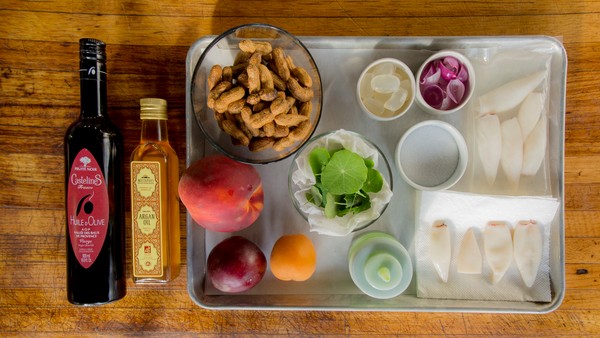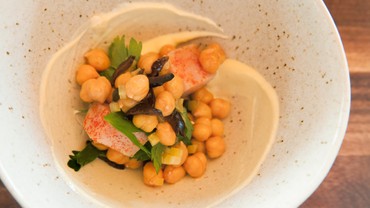Plating and Servingtypes
We've all been to that dinner party. The one where one half of the host couple is out of sight most of the evening, emerging only to bark an order at the poor partner—who is only trying to keep the guests entertained and distracted from whatever disaster is clearly going down in the kitchen. And we've been the one in the kitchen, too, sweating our way through each course, swearing loudly because the sauce is burning on the stove and there are no clean spoons to stir it with, cursing the clock as our guests stand around awkwardly, overdoing it on wine as the evening wears on and still no food has materialized.
This is the last thing you want to happen when you're debuting an awesome dish you've worked so hard to master. And an in-the-weeds evening can be avoided, provided you're ready to exercise some discipline and care. For starters, you're going to need to practice your dish several times before service, so that you know how to best arrange your mise en place and work station. You'll want to remove any unnecessary clutter from your counters. Decorative fruit baskets, coffee grinders, picture frames—get those out of there. Finally, plan on cleaning as you go. (Pro tip: pay the neighbor kid to wash dishes and help prep). Cooking clean is the single best way to up your kitchen skills and ensure a successful event. Read on to learn everything you need to know to successfully execute your dish, then send out the invites. It's time to wow your nearest and dearest.
Note: This content is part of our Design a Dish project, which used Nick's Nasti Salad Soup as a case study for how to create a composed plate. You'll find notes on how we executed the dish for a recent dinner party in italics below.
Prep mise en place
We can't say this enough: Carefully putting together your mise en place will save you every time. Give yourself time to make it enjoyable—pour a glass of wine, cue up a favorite playlist, and indulge in the meditative peacefulness that comes from readying a great meal.
Peel and trim vegetables. Transfer oils and sauces into squeeze bottles or covered pots ready to be heated. If reheating a sauce, ready it for the sous vide bath. Trim herbs and store neatly between two cold, damp paper towels. The trick here is to prep as much as possible without sacrificing quality.

Case Study: Prepping mise en place
We were able to make a number of components—like the scallop brine and nasturtium purée—ahead of time. We prepped our onions and plum pieces, peeled peanuts, and sliced palm seeds for our mise. We sliced our brined scallops and carefully prepped nasturtium flowers for garnish. We made sure the argon oil and salt were ready to go, and the limes were juiced.
Organize your work station
Before you lay things out on your work station, write down every step required to create the dish. You can consult the steps as you go to stay confident you haven't forgotten anything. Similarly, keeping a handy list of all the components of the dish will prevent you from forgetting an ingredient as you cook and plate.
Next, think back to when you tested the dish and organize your station accordingly. Which components did you want within reach when? There's no need to have garnish out on the counter during the first stages of cooking, for instance. Keep things clean and clear to help you avoid spilling and such.

Case study: organizing your work station
Simple: We pre-trimmed delicate herbs and stored them in the fridge until we got close to plating, then made sure they were on hand when everything else was ready to go.
Chill or heat plates or bowls
Picking the right plate or bowl is an important plating step, of course. Even more vital than the vessel itself: how you store it. When serving chilled soup, always keep bowls in the fridge or freezer. If you're preparing a warm meat course, keep that serviceware warm in in a 200 °F / 93 °C oven. (NOTE: You may think a 200 °F / 93 °C plate feels too hot when you're plating in the kitchen, but don't panic: It will lose heat rapidly as you carry it out to the dining room, and it will be warm, but not too hot, when your guest receives it.)
Keeping your plates and bowls at the proper temperature will do wonders when you plate up, buying you time at the most important moment—ice cream will melt slower, proteins will stay warm longer, and you'll be able to focus on assembling the dish.

Case Study: Chilling plates or bowls
This was a dish with highly sensitive ingredients—it's a race against time to get the composed plate to the table before the purée starts weeping, and the scallops warm up to room temp. Chilling the bowls in the fridge at the start of the process gives us a wider window during the plate-up, to ensure all the unctuous textures and refreshing flavors stay intact until the guest starts eating.
Keep it clean
One of the biggest mistakes that home cooks make is forgetting to keep things clean as they go. This is a surefire way to ruin a multicourse meal as you run out of counter space and usable tools. Clean tools right after you use them and put them back where you can easily find them. Don't let pots and pans pile up in the sink if you need the space later. In the heat of the moment, this can be a tricky thing to stay on top of, especially when your attention is on the meal at hand. But trust us: keeping it clean will significantly improve your workflow and help your mind focus on the food and not the mess surrounding it.

Case Study: keeping it clean
What can we say? Our kitchen stays spotless. We've been deep in the weeds enough times to know that a messy work space is a surefire way to have a terrible evening of cooking. This is especially true for chefs, who often find themselves working in private homes or unfamiliar commercial kitchens. In addition to washing dishes as we go, we arrive early to prepare the kitchen for service. We clear the counters of decorative baskets or unnecessary gadgets, and transfer fridge contents to a cooler or secondary fridge to make room for all our ingredients and cut down on clutter. It's all about optimizing the space for smooth service. Because we always like to leave it the way we found it, we take an iPhone picture of the kitchen before we change anything so we can put everything back in its proper place at the end of the night.
Show that dish off!
Listen, beautifully plated dishes—the kind that take time and patience to develop—can be hard to find outside of fancy restaurants. Creating your own composed dish is a real accomplishment, so go ahead and show off a little. Instagram that badboy or upload it to your Chefsteps profile.

Popular Recipes




